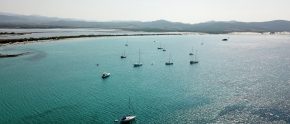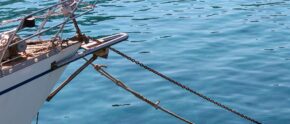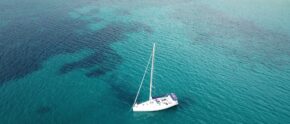Finding the right anchorage
Selecting an anchorage
It is always prudent to survey the anchor location using binoculars and detailed navigational charts to have a clear picture of the shoreline. Take your time to find out important factors such as water depth near the shore, shelter from the land by groups of trees, hills or cliffs, prevailing or forecasted winds well before you drop the hook. Also, you should consider that wind directions may change when a storm is about to descend or the weather looks unsettled. Looking out at the horizon and checking the barometer and the swell is enough in most cases to get a good idea about how the weather will turn out. Also, some weather apps feature a rain radar showing approaching rain and storm fronts several nautical miles away.
Secluded bay
Once you have selected a lonely anchorage, slowly approach keeping the water depth in mind. If no other vessels are at anchor, you are ready to drop anchor when you have reached the desired water depth and distance to the shore.
Lively anchorage
Things are different when you find a crowded anchorage. In this case, you should first drive slowly staking out your chosen spot to approximate distances to neighbouring vessels, which is not possible from afar. Setting your anchor too close to a yacht, you might not be able to let out enough rope rode or chain. Also, you risk that your anchor breaks out when the wind and wave action pick up and fouls your neighbour’s chain. Letting out plenty of rode will increase your swinging radius, though, and then there is the risk of a collision.
Swinging room
All boats lying in an anchorage behave differently. Light, high freeboard short keels tend to move back and forth while heavy yachts with a relatively long keel hardly shift position. And in upcoming bad weather you might be the one who was dealt a “poor hand”. If you are on the unlucky boat dragging through a crowded anchorage, you will either have your anchor stuck in other people’s lines endangering them and others, or drift on the nearest sandbank, because in the heat of the moment the dinghy’s rode fouled your prop. And on top of it all, this will happen in the dead of night and with the wind howling: Murphy’s Law at its best.
Solitary yacht on anchor

Staking out a spot
Slowly staking out your intended anchorage has yet another advantage: if the light conditions are favourable and the water clear enough, you might have a good view of what you’re sinking into. Near the shore, lighter patches alternate with deep shadows, with the lighter sand patches being ideal for any type of anchor. If the bottom is homogeneously dark, this usually means that you are over silt where most anchors hold reasonably well, or over grass or weed that do not provide a good holding ground and should be avoided.
Tip: Use your dinghy’s grapnel to rake through the ground and retrieve a sample: its flukes are shaped like spoons and will get you enough material to see what you are dealing with. Also, this anchor is highly useful to retrieve and free your ground tackle if it is fouled under that of your neighbour.



